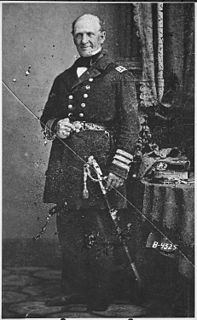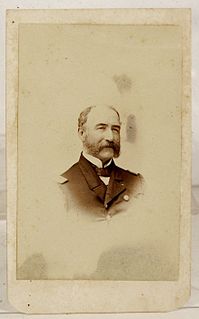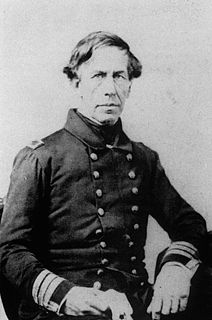
David Glasgow Farragut was a flag officer of the United States Navy during the American Civil War. He was the first rear admiral, vice admiral, and admiral in the United States Navy. He is remembered for his order at the Battle of Mobile Bay usually paraphrased as "Damn the torpedoes, full speed ahead" in U.S. Navy tradition.

John Rodgers was an admiral in the United States Navy. He began his naval career as a commander in the American Civil War and during his Postbellum service became an admiral.

Francis Hoyt Gregory was an officer in the United States Navy during the War of 1812 through to the Civil War, serving then as a Rear Admiral.

Rear Admiral Silas Horton Stringham was an officer of the United States Navy who saw active service during the War of 1812, the Second Barbary War, and the Mexican–American War, and who commanded the Atlantic Blockading Squadron at the beginning of the American Civil War.

Commodore Josiah Tattnall, Jr. was an officer in the United States Navy during the War of 1812, the Second Barbary War and the Mexican–American War. He later served in the Confederate Navy during the American Civil War.

Louis Malesherbes Goldsborough was a rear admiral in the United States Navy during the American Civil War. He held several sea commands during the Civil War, including that of the North Atlantic Blockading Squadron. He was also noted for contributions to nautical scientific research.
Ralph Chandler was a Rear Admiral of the United States Navy. He saw action during the Mexican–American War and the American Civil War, and later served as Commander of the Asiatic Squadron.

Lewis Warrington was an officer in the United States Navy during the Barbary Wars and the War of 1812. He temporarily served as the Secretary of the Navy.

Henry Walke was an officer in the United States Navy during the Mexican–American War and the American Civil War.

William Branford Shubrick was an officer in the United States Navy. His active-duty career extended from 1806 to 1861, including service in the War of 1812 and the Mexican–American War; he was placed on the retired list in the early months of the Civil War.

The second USS Lexington was a sloop in the United States Navy built at the New York Navy Yard in Brooklyn, New York, in 1825; and commissioned on 11 June 1826, Master Commandant William B. Shubrick in command.

James Alden Jr. was a rear admiral in the United States Navy. In the Mexican–American War he participated in the captures of Veracruz, Tuxpan and Tabasco. Fighting on the Union side in the Civil War, he took part in the relief of Fort Pickens, followed by many engagements on the Lower Mississippi, before being promoted Captain of USS Brooklyn and assisting in the Union victory in the Battle of Mobile Bay.
Stephen Decatur Trenchard was a rear admiral in the United States Navy. He was present at the Battle of Taku Forts in 1859, and commanded the supply ship and gunboat Rhode Island throughout the American Civil War, seeing action at both Battles of Fort Fisher. He later commanded the North Atlantic Squadron.

Rear Admiral Henry Kuhn Hoff was a United States Navy officer. During his long career, he took part in combat in Sumatra and in the American Civil War.

Rear Admiral Frederick W. Rodgers was an officer in the United States Navy. He fought in the American Civil War and rose to be the last commander of the Asiatic Squadron. He was a grandson of U.S. Navy Commodore Matthew C. Perry.

Commodore Cicero Price was an officer in the United States Navy. He served in the American Civil War and was commander of the East India Squadron.

Thomas Tingey Craven was a 19th-century United States Navy officer who rose to prominence during the Civil War.

William Edgar Le Roy was an officer in the United States Navy who served in the Mexican War, on the African Slave Trade Patrol, and in the American Civil War. He rose to the rank of rear admiral and late in his career was consecutively commander-in-chief of the South Atlantic Squadron, the North Atlantic Squadron, and the European Squadron.
Samuel Evans was a long-serving officer in the United States Navy. Evans served with distinction during Quasi-War with France, the First Barbary War and the War of 1812. He later served as the commandant of the New York Navy Yard from 1813 until his death in 1824.
























